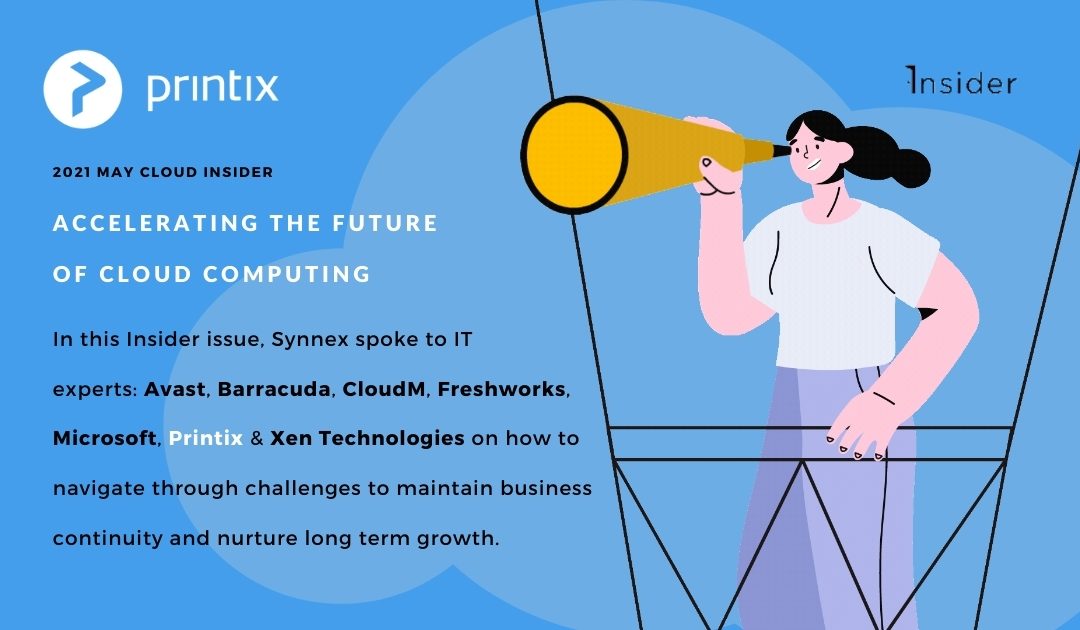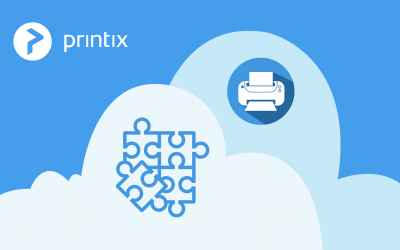In the current unprecedented environment, most companies are adopting hybrid cloud strategies and choose to use multiple cloud platforms at the same time. In its 7th Cloud Insider Issue, Synnex spoke to IT experts from Avast, Barracuda, Microsoft, Printix, Freshworks, CloudM and Xen Technologies on how to navigate through looming perils to maintain business continuity, while nurturing long-term growth.
The impact of COVID-19 over the past year has shown that businesses that embrace digital transformation are more resilient and can transform their business models faster in the face of challenges.
“What we have witnessed over the past year is the dawn of the second wave of digital transformation sweeping every company and every industry. Building their own digital capability is the new currency driving every organisation’s resilience and growth.” ~ Satya Nadella, Chief Executive Officer, Microsoft
Witnessing the current fundamental changes in consumer behaviour, businesses are investing more than ever in digital transformation.
This edition pinpoints:
- Resilience and business continuity drivers
- Top cloud channel’s priorities
- Achieving long-term growth
- Leveraging finance and cloud solutions
- MSP’s growth despite the global crisis
COVID-19 has become a catalyst for rapid cloud migration
COVID-19 crisis showed us why cloud migration is inevitable. With the onset of the COVID-19 crisis, we have exposed our daily lives to the cloud, providing alternative ways of connectivity, access to sensitive data, and real-time collaboration through distance learning and working remotely. The “new normal” forced organisations to embrace change and shape new business models.
Organizations are continuing to increase their cloud spend rapidly
In 2021 increased spending and cloud adoption initiatives remains a top priority for all organisations. Building infrastructure to support the cloud now accounts for more than a third of global IT spending. Meanwhile, traditional IT spending declines as IT efforts continue to be focused on cloud migration.
Cloud computing statistics you need to know
Let’s have a look at Gartner‘s Cloud adoption statistics:
- The public cloud service market is expected to reach $623.3 billion by 2023 worldwide.
- 83% of enterprise workloads will be in the cloud by 2021.
- 94% of enterprises already use a cloud service.
- 30% of all IT budgets are allocated to cloud computing.
- 66% of enterprises already have a central cloud team or a cloud centre of excellence.
- Organisations leverage almost 5 different cloud platforms on average.
- 50% of enterprises spend more than $1.2 million on cloud services annually.
“Many businesses are discovering that a one size fits all strategy for choosing a cloud platform not working for them.” ~ Ben Ayache, Regional Alliances Manager APAC at CloudM
Microsoft reported in April 2020 it had experienced ‘two years’ worth of digital transformation in two months, with over 200 million people taking part in Microsoft Teams meetings, generating over 4.1 billion meeting minutes on a single day.
Cloud Migration for Better Assessment & Planning
Businesses that used subscription models like Cloud Solution Providers (CSPs) were able to retain recurring revenue streams and assist customers who needed to decrease or increase user counts as needed.
“Many channel partners who had already adopted Cloud services like Microsoft 365 proved to be well placed when lockdowns started.” ~ Philip Meyer, Partner Technology Strategist at Microsoft
According to Meyer, many customers under economic pressure have given up on the array of security vendors (ranging from 6 to 26 different vendors) and rationalized to Business Premium to cover the full spectrum of Security and Management.
Unlocking business acceleration in a hybrid cloud world
The adoption of cloud infrastructure leads to greater business agility, broader geographical distribution, and scalability. The cloud proved its worth, and the market has matured enough to enable organisations to move to the cloud and update their legacy infrastructure.
”A long-term digital strategy that includes a multi-cloud approach and avoids vendor lock-in is imperative for building resilience and agility”~ Ben Ayache, Regional Alliances Manager APAC at CloudM
How to navigate in turbulent times and identify key channel priorities
The goal of programmatically uncovering growth opportunities is to make it easier for users to adopt and deploy comprehensive security solutions.
“For many years, the adoption of the cloud was naturally accelerating. Today, every company is essentially a technology company and if the exponential growth rate during the last decade, particularly the last 12-18 months, is anything to go by, it is safe to say that the cloud represents a hybrid IT future moving in a cross-functional manner.”~Agartu Dinegde
Any industry that is moving beyond cloud certifications should rethink the way it works and survives, as well as how the new post-pandemic reality requires new skills and roles, as well as a highly adaptive mindset that serves customers in a variety of novel ways.
Top 5 cloud channel priorities
- Trend 1: Cloud migration expertise
- Trend 2: Enhanced Security
- Trend 3: Remote capabilities
- Trend 4: Bundled solutions
- Trend 5: Productivity boosting features
IT departments must take steps to prepare themselves for how cloud computing changes security, performance, integration, governance, policies, and user access – and then organize employees so they can effectively manage the cloud.
“The application roadmap must be looked at with every decision thoroughly evaluated before investing” ~ Sreelesh Pillai, General Manager, Freshworks Australia
Making better decisions is enabled by knowledge and insights. Using free trials and obtaining the results of these trials is a common way to collect the data that is necessary to make decisions.
Steve Lyne, Vice President, Global Co-Sell and Alliance at Printix, explains that for proper implementation of secure cloud printing, this typically refers to the removal of print server hardware, associated software licenses, and excessive IT administration.
Printix Cloud Print Management solution delivers print infrastructure for the cloud with a broad range of migration and administration tools in a single platform. It allows you to build a new print environment or move existing services to the cloud with confidence.
The main benefit of a cloud-based print solution like Printix is that it drastically simplifies your print infrastructure, and smooths the administrative complexities involved in managing diverse hardware, software, computer operating systems and vendor-specific printer requirements.
Printix allows IT, administrators, to manage services rather than servers and lets users print reliably, instead of having to deal with printing problems. Adopting a cloud strategy for print saves time and money, allows IT resources to focus on value-add activities and improves productivity as well as job satisfaction.
“Printix is the missing piece to complete your cloud office migration.”~Steve Lyne, Vice President, Global Co-Sell and Alliance at Printix
Channel partners face multiple security, governance, privacy, and compliance concerns. Each of these disciplines is tightly connected, so no single technique or software can solve them all.
According to Rob Krug, Senior Security Architect with Avast Business, software-defined security with Secure Access Service Edge (SASE) design can make management much easier and more accurate. With the right IT partners, businesses and customers can protect their data with confidence while complying with all necessary regulatory requirements.
How working from home affected cloud migration
During the Covid-19 pandemic, the rise of the managed security service providers has been caused by security, privacy, and compliance issues related to working from home. A FlexJobs survey of more than 2,100 remote workers conducted during the pandemic found that 65 % expect remote or hybrid work models as the “new normal” in near future.
“Zero Trust Networks are one of the top growth areas. Zero Trust Networks give users secure remote access to applications and services based on defined access control policies.”~Andrew Huntley, Barracuda’s Regional Sales Director
In preparation, over 61% of customer service leaders have increased their budgets and investments in hardware, analytics, and collaboration software. A remote-ready technology stack can have a big impact on how quickly teams respond to a variety of situations while working from anywhere. The right data centres have the right security, privacy, and GDPR policies in place.
Planning for success with a smart cloud computing strategy
Identifying and dealing with obstacles before they escalate into irreversible problems is essential to successful planning. If you plan to migrate a network, deploy it, or reconfigure it, you should consider all pros and cons, document all processes and consult with key stakeholders along the way.
Having the right support from the start is key. Support from the start is crucial to achieving the best results from a fully implemented system, says Ayache, “Make sure the people who will be using the new system are well informed and enthusiastic about the change as adopting new working methods can be difficult.”
The challenge: Decision-makers need to understand every cost to their business
In today’s climate, it is not only important for businesses to have stable, reliable IT infrastructure, but it is critical to be aware of and understand every cost to the business.
It is important for companies to look for technology that helps them oversee and control their customers. By removing the burden created by large break-fix bills and providing regular maintenance, managed services help businesses run more smoothly while removing their own pain points.
IT teams will be able to perform basic business processes more quickly with greater governance and 24/7 monitoring. Preventative tasks were in the past subject to approval by the customer, who could decide whether or not they wanted the work completed. Today cloud-based solutions intuitively take care of the end user’s pain points.
How Printix can contribute to your cloud migration efforts
With Google Workspace and Chromebooks, a reliable cloud platform for managing print can be deployed. Users can easily and securely print from any location to their company or school printers when using Printix, which automates connection and management. System administrators can now sync and manage files much more easily with Printix’ Google Workspace integration and authentication.
“We see the Printix solution becoming an essential part of any Microsoft modern workplace solution, especially for businesses looking to reduce infrastructure costs and improve document management security.” ~Greg McCallum, Chief Technology Officer at Virtuoso
Printix has leveraged cloud technology and Microsoft Azure AD integration to bring modern print management to the cloud quickly, efficiently and inexpensively. Replicating your on-premise print environment and print server configurations in the cloud, Printix enables you to remove print servers and complete your cloud migration simply and with no disruption to users.
Request a free trial here >>
Download the 7th Synnex Insider Issue here >>




